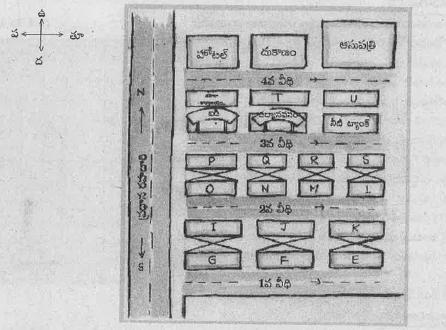కింది ఇచ్చిన క్రమ యుగ్మ లను గ్రాఫ్ కాగితం పై గుర్తించి మీ పరిశీలను రాయండి. (1,0), (3,0), (−2,0), (−5,0), (0,0), (5,0), (−6,0)
Step by step video & image solution for కింది ఇచ్చిన క్రమ యుగ్మ లను గ్రాఫ్ కాగితం పై గుర్తించి మీ పరిశీలను రాయండి. (1,0), (3,0), (-2,0), (-5,0), (0,0), (5,0), (-6,0) by Maths experts to help you in doubts & scoring excellent marks in Class 9 exams.
Updated on:21/07/2023Topper's Solved these Questions
- నిరూపక జ్యామితిBOOK - VGS PUBLICATION-BRILLIANT(TELUGU)CHAPTER - నిరూపక జ్యామితిEXERCISE - Exercise
87 Videos
- త్రిభుజాలుBOOK - VGS PUBLICATION-BRILLIANT(TELUGU)CHAPTER - త్రిభుజాలుEXERCISE - Exercise
89 Videos
- బహుపదులు మరియు కరణాంకా విభజనBOOK - VGS PUBLICATION-BRILLIANT(TELUGU)CHAPTER - బహుపదులు మరియు కరణాంకా విభజనEXERCISE - Exapmle
15 Videos
Similar Questions
ఒక ఆవాస ప్రాంతంలో ప్రధాన రహదారి ఉత్తర-దక్షిణ దిశలలో ఉంది. దాని పటం కింది ఇవ్వబడినది. పటం సహాయంతో కింది ప్రశ్నలకు సమాధానాలు వ్రాయండి.
 తూర్పుదిక్కున వెళ్లునప్పుడు మూడవవీధిలో ఎడమవైపు మూడోవస్థానంలో ఏం ఉంది?
తూర్పుదిక్కున వెళ్లునప్పుడు మూడవవీధిలో ఎడమవైపు మూడోవస్థానంలో ఏం ఉంది?
View Solutionచతుర్భుజం ABCD లో , AC=AD మరియి ∠A కు AB కోన సమద్విఖండన రేఖ అయిన ΔABC=ΔABD అని చూపండి. BC మరియు BD ల గురించి మీరు ఏమి చెప్పగలరు?

View Solutionకింద ఇవ్వబడిన బాహుపదులలో సూచించిన చరరాశి విలువను ప్రతిక్షేపించి విలువలు కనుగొనండి. X=1 వద్ద p(x)=4x2−3x+7
View SolutionThe point on the x-axis which is equidistant from points (−1, 0) and (5, 0) is (0, 2) (b) (2, 0) (c) (3, 0) (d) (0, 3)
View SolutionThe point on the axis which is equidistant from (-4,0) and (10,0) is ,
a) (7,0)
(b) (5,0)
c) (0,0)
d) (3,0)
View Solutionयदि A=[2500] और B=[50−20] हो, तो AB का मान ज्ञात कीजिये।
View SolutionFoci are (±3,0) and vertices (±5,0)
View SolutionPlot the following ordered pairs on a graph sheet. What do you observe?
(i) (1,0), (3,0), (-2,0), (-5,0), (0,0), (5,0), (-6,0)
(ii) (0,1),(0,3),(0,-2),(0,-5),(0,0),(0,5),(0,-6)
View SolutionPlot the following ordered pairs on a graph sheet. What do you observe?
(i) (1,0), (3,0), (-2,0), (-5,0), (0,0), (5,0), (-6,0)
(ii) (0,1),(0,3),(0,-2),(0,-5),(0,0),(0,5),(0,-6)
View SolutionPlot the following ordered pairs on a graph sheet. What do you observe?
(i) (1,0), (3,0), (-2,0), (-5,0), (0,0), (5,0), (-6,0)
(ii) (0,1),(0,3),(0,-2),(0,-5),(0,0),(0,5),(0,-6)
View SolutionPlot the following pairs of points on the axes and join them with line segment
(1,0), (0,9), (2,0), (0,8), (3,0), (0,7), (4,0), (0,6)
(5,0), (0,5) (6,0), (0,4) (7,0) (0,3), (8,0), (0,2), (9,0), (0,1)
View SolutionPlot the following ordered pairs on a graph sheet. What do you observe?
(i) (1,0), (3,0), (-2,0), (-5,0), (0,0), (5,0), (-6,0)
(ii) (0,1),(0,3),(0,-2),(0,-5),(0,0),(0,5),(0,-6)
View SolutionPlot the following pairs of points on the axes and join them with line segment
(1,0), (0,9), (2,0), (0,8), (3,0), (0,7), (4,0), (0,6)
(5,0), (0,5) (6,0), (0,4) (7,0) (0,3), (8,0), (0,2), (9,0), (0,1)
View SolutionPlot the following pairs of points on the axes and join them with line segment
(1,0), (0,9), (2,0), (0,8), (3,0), (0,7), (4,0), (0,6)
(5,0), (0,5) (6,0), (0,4) (7,0) (0,3), (8,0), (0,2), (9,0), (0,1)
View SolutionThe point on the axis which is equidistant from (-4,0) and (10,0) is ,
a) (7,0)
(b) (5,0)
c) (0,0)
d) (3,0)
View Solution
